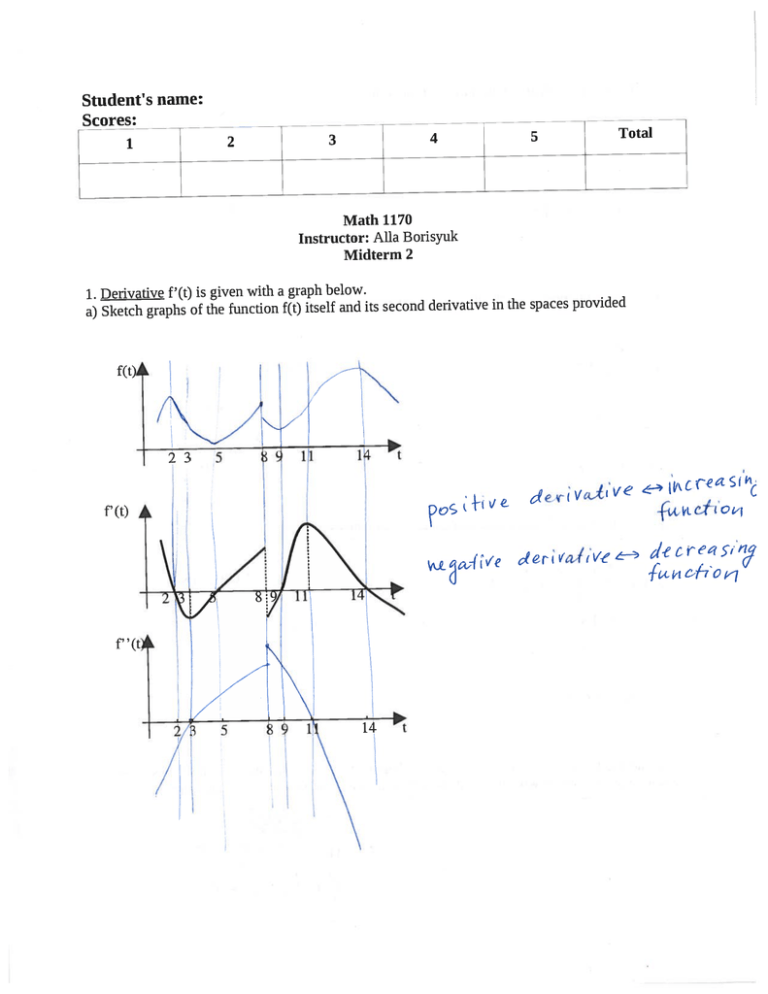c rei Student’s name: Scores: Math 1170
advertisement

Student’s name: Scores: 1 2 Total 5 4 3 I L 1 Math 1170 Instructor: Alla Borisyuk Midterm 2 1. Derivative f’(t) is given with a graph below. spaces provided a) Sketch graphs of the function f(t) itself and its second derivative in the f’ (t) i’Ve c rei b) What are the critical points? Points of inflection? .(>c)O} 1 2,S’,?,f) 3 I H c) On which intervals does the function increasing? decreasing? - J -[ ih ? (() 2X-5 >iq d) On which intervals is the function concave up? concave down? --- EI( wre + 3 )(-c? s, e) If the argument t is time (in hours from the beginning of the experiment), and f(t) describes size of a population, at what time did the population have the largest rate of growth? -M H 4h Ictrcjet @1’_zç 1fVa-/iV 2. The number of flies in the room (N) depends on temperature (T, degrres Celcius) as N. The level of social skills 2 20). The IQ level (Q) goes down with the number of flies as Q(N)=e (S) depends on the IQ as S(Q)=11Q. a) Find the derivative of S as a function of T N(T Cire Co ofrvipOV). ( ot “I. 1’.! L I / — (r- S(1), Y’/2ot (‘N) o) e. k’ —2 t ‘ s() — /J(’y). 3y .I 3(’T-2) 2 ‘(y)3ci 2. I1,’r / f\\ = ( * 3 (r-2c) L _2(r-20) ‘ z (rzc b) If the temperature goes up from 20 to 21 degrees, will the level of social skills go up or down? so dQeJ flQ’-/ hI p. 1 c() 8 vcr&a5i1 ‘-Tb .Lte1-1O1’t £&tieIc kIIl iç’ 3. Consider the following dynamical system: x+i2.5x(1-x) a) Find the steady states and their stability algebraically, using the updating function and its de rivative 2c(( -x — 2,((J 0 0 x yo or x* . ZzO- 3 g,’E. 4 1 2c—3 —t_fe. -I -o.rt-) 0.3, if we wa1TTiI 0 b) What do you think will happen to the solution which starts with x time? Sketch this solution as a function of time. (Hint: doing a quick cobwebbing drawing may help but is not required) o ;s j t ,g .4b/’ ‘(‘Y j ii $0 -H //tre wi (( cfp(c9 ll c%/ L 4 + >c U —[ o \/ ‘I It - N h > N It N I It - N )‘ — i )c ‘ -s ri —. - U —::: II — 0• 0 rD . p V V 0 ,J J 0 Tjfl 5. Find first and second derivatives of the following functions: a) g(s)’ in(s)/s s 4 -i - H---e4 S - —S—Z5fr2S-5 (s) b) g(x) = = ’e 2 e ’ 4 . (Hint: simplify, and then take the derivatives) —‘x e a ’c 6 —3t2—









